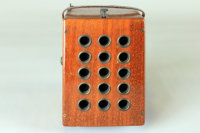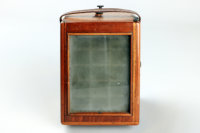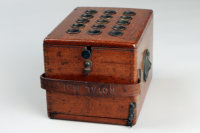Royal Mail Postage Stamp Camera,
1907-1915
2020/58


Camera
This is a Royal Mail Postage Stamp Camera. It was produced between 1907 and 1915 by W. Butcher & Sons of London. The business started as a pharmacy that sold the chemicals required to develop photographs. As the popularity of photography grew, the company was inspired to begin manufacturing their own range of cameras in 1889.Novelty
The Royal Mail Postage Stamp Camera is a multiplying camera fitted with fifteen lenses. This allows it to take fifteen identical postage stamp sized photographs in a single exposure. It was sold as a novelty camera and specially decorated developing papers were available to complete the postage stamp look.Plate
This camera was designed to use dry plate negatives. Dry plates are sheets of glass coated in a gelatine emulsion. Before the process was invented in 1871 photographers needed to quickly coat, expose and process ‘wet’ plates in one sitting. Dry plates could be transported, exposed, and then processed later.Reproduction
This multiplying camera can produce fifteen smaller copies of an artwork. Walter Benjamin explored how these methods of technological reproduction changed the nature of art in his 1936 essay Art in the age of Mechanical Reproduction. Benjamin argues technological reproduction results in a loss of uniqueness, but also makes art more accessible, democratic, and political.

Royal Mail Postage Stamp
Camera, 1907-1915
1993/132


Camera
This is a Royal Mail Postage Stamp
Camera. It was produced between
1907 and 1915 by W. Butcher & Sons
of London. The business started as
a pharmacy that sold the chemicals
required to develop photographs.
As the popularity of photography grew,
the company was inspired to begin
manufacturing their own range of
cameras in 1889.
Novelty
The Royal Mail Postage Stamp Camera
is a multiplying camera fitted with
fifteen lenses. This allows it to take
fifteen identical postage stamp sized
photographs in a single exposure.
It was sold as a novelty camera and
specially decorated developing papers
were available to complete the postage
stamp look.
Plate
This camera was designed to use dry
plate negatives. Dry plates are sheets
of glass coated in a gelatine emulsion.
Before the process was invented in
1871 photographers needed to quickly
coat, expose and process ‘wet’ plates
in one sitting. Dry plates could be
transported, exposed, and then
processed later.
Reproduction
This multiplying camera can produce
fifteen smaller copies of an artwork.
Walter Benjamin explored how these
methods of technological reproduction
changed the nature of art in his 1936
essay Art in the age of Mechanical
Reproduction. Benjamin argues
technological reproduction results in
a loss of uniqueness, but also makes
art more accessible, democratic, and
political.


